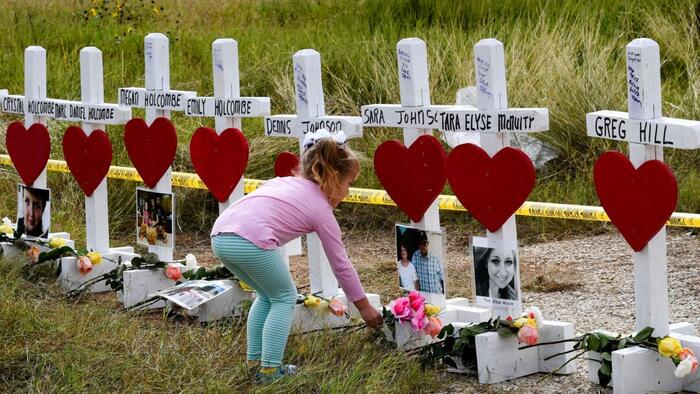On January 17, 1989, Rob Young, then a six-year-old boy, made his way to school, excited about the new LA Gear tennis shoes gifted for Christmas. His anticipation quickly turned to horror as an armed gunman opened fire at Cleveland Elementary School in Stockton, California. Amidst the chaos of children screaming and running for safety, Young suffered injury; he recalled a bullet striking his foot and another embedding in his chest, which remains there to this day. This tragic incident resulted in the deaths of five children and injuries to 30 others, including a teacher. In the aftermath, California introduced groundbreaking legislation—an early ban on certain semiautomatic rifles, setting a precedent that resonated across the United States. The legacy of the Stockton schoolyard shooting led to extended conversations on gun control, particularly as mass shootings continued to plague the nation, bringing the issue to the forefront of political discussions to this day.
Fast forward to September 2022, President Joe Biden initiated the first White House Office of Gun Violence Prevention, signaling a sustained governmental effort to manage gun-related tragedies. Biden’s administration executed executive orders aimed at regulating homemade firearms and promoting active shooter protocols in educational environments. Vice President Kamala Harris highlighted a dual commitment to protecting the Second Amendment while advocating for measures like the reinstatement of the assault weapons ban, universal background checks, and red flag laws. Through this discourse, many survivors of mass shootings emerged as advocates for stricter gun control laws, seeking to prevent future tragedies while navigating the complexities and emotional weight of their experiences.
While some survivors embraced a pro-gun control stance, Rob Young chose a different path. He became a law enforcement officer, believing that responsible gun ownership is essential to combat potential threats. Young argues that the weapon itself is not to blame for the violence; rather, it is the individuals who wield them maliciously. He pointed out that the Stockton shooter ended his rampage only when he realized police were on the scene. In Young’s view, praising or blaming the inanimate object overlooks the root of the problem: violent criminals, not the guns they use. This philosophy resonates widely, particularly among those who advocate for the right to bear arms as a vital component of public safety.
Zachary Poston shared a similar belief following his harrowing experience during the mass shooting at the First Baptist Church in Sutherland Springs, Texas, on November 5, 2017. During the attack, Poston witnessed the quick actions of armed citizen Stephen Willeford, who intervened with his own weapon against the assailant, ultimately stopping further violence. This incident left a profound impact on Poston and others in the community, reinforcing the notion that being armed can save lives in critical situations. Unlike advocates for stricter gun control, who assert that access to weapons leads to higher incidences of violence, Willeford and Poston argue that their experience exemplified the necessity of being able to respond defensively when faced with danger.
Numerous survivors who experienced violence expressed relief that some assailants encountered armed resistance rather than going unchecked. Retired police officer Massad Ayoob noted that gun control advocates sometimes neglect the accounts of individuals whose lives were saved by responsible gun owners who were present during such crises. He spoke at events emphasizing the counter-narrative to gun control debates, where survival stories spotlight armed interventions that thwart mass shootings. Similarly, Nashville police officer Michael Collazo recounted his experience responding to a shooting in a school setting, where, despite efforts made by the staff to manage the threat, only armed responders were able to neutralize the assailant effectively. These accounts highlight a recurring theme among gun rights supporters: that preparedness and personal responsibility can serve as life-saving tools during violent encounters.
The conversations surrounding gun access and ownership remain heated, with contrasting opinions on how best to mitigate mass shootings and violent crime. While some survivors, like Young, make a case for allowing more people to carry firearms for self-defense, others counter the argument with calls for stricter controls and regulations, especially regarding assault weapons. Advocacy groups such as Brady: United Against Gun Violence argue that limiting the availability of high-capacity firearms would directly reduce the severe impact of mass shootings. They advocate a reintroduction of the Federal Assault Weapons Ban, emphasizing public support for legislative changes aimed at enhancing community safety. This ongoing debate continues to polarize opinions, as Americans grapple with the challenge of safeguarding their rights while ensuring the security and well-being of society.
Ultimately, the experiences of those affected by gun violence, coupled with the policies that arise from their stories, shape the evolving landscape of gun legislation in America. As survivors like Rob Young and Zachary Poston advocate for differing perspectives on gun ownership and control, their narratives reflect the complex relationship between rights and public safety in a nation grappling with the shadows of violence. As discussions continue within political, social, and personal spheres, the urgency to find effective solutions to prevent mass shootings and promote responsible gun ownership remains a pressing issue that demands attentive consideration across all facets of society.

